| Reviews & Columns |
|
Reviews DVD TV on DVD Blu-ray 4K UHD International DVDs In Theaters Reviews by Studio Video Games Features Collector Series DVDs Easter Egg Database Interviews DVD Talk Radio Feature Articles Columns Anime Talk DVD Savant Horror DVDs The M.O.D. Squad Art House HD Talk Silent DVD
|
DVD Talk Forum |
|
|
| Resources |
|
DVD Price Search Customer Service #'s RCE Info Links |
|
Columns
|
|
|
Ultimate Matrix Collection: Limited Edition, The
—Neo
Easily weighing in as the most exhaustive DVD treatment of a film series in 2004, The Ultimate Matrix Collection is daunting in its mere description—10 discs holding everything you ever wanted to know about The Matrix trilogy. Debuting in two incarnations—a standard edition and a Limited Edition—that vary only in their packaging, the set is a Matrix monster, plugging you in to a brand-new visual presentation of the first film and assembling a vast array of heretofore unseen special features and, for good measure, also throwing in some stuff you might already have in your collection.
Particularly if you're a fan of the saga, this set is going to deliver some redundancy. But can you resist the sheer coolness of this comprehensive behemoth? The Ultimate Matrix Collection is a scrumptious, only slightly flawed film-school compendium of a remarkable series of films, and even if your reactions to the Wachowskis' cerebral trilogy were of increasing disappointment as it approached its narrative climax, this set will give you a much deeper understanding of the astonishing intellectual scope of the project and will show you exactly what it was like to be on the sets, making these films. The Ultimate Matrix Collection truly lives up to its title.
THE FILMS
When we first spoke of The Matrix, it was in hushed tones—"What is the Matrix?" we whispered, echoing the film's mysterious and compelling marketing campaign. Bolstered by obviously groundbreaking effects and a foundation in sci-fi kung-fu noir, the trailers hooked us at soul level, and we flocked to the cineplex like true movie geeks. When that Matrix code began raining down the screen, we knew we were in for something special, and the film—written and co-directed by Andy and Larry Wachowski—delivered on its multi-layered promises. The Matrix exploded at the box office, at once thrilling audiences with its spectacularly choreographed action sequences and engaging the mind with its underlying explorations of religious motifs, age-old philosophical questions, and mythological constructs. More than anything else, perhaps, it was a film that supremely kicked ass.
Or perhaps you, like me, required a second viewing to truly appreciate The Matrix. It's a dense creation, and on first viewing, it's almost too much to process. On the surface, it's a rousing, immersive sci-fi actioner, filled with neo-noir set-pieces, energetic wire-fu (little seen in American cinema at the time), surprisingly effective martial-arts clashes among the principal cast, and blistering special-effects innovation. The film's "Bullet Time" sequences have been an endless source of homages and ripoffs since 1999, when The Matrix hit screens, and the film's dark, seamless CG landscapes proved instantly provocative. Taken as only that—a sci-fi techno joyride—The Matrix is an already entertaining and groundbreaking film, but it's the deeply resonant story within, the stuff that's going on underneath the stylish escapism, that makes the film remarkable.
The Matrix begins in the world of today but escapes this realm in a way heretofore relegated to world of ideas. Computer hacker Thomas Anderson (Keanu Reeves)—who goes by the hacker alias Neo—is living a life of quiet desperation and foundering in the grip of a stifling corporate career. One day, as if yanked by fate, he's contacted by the stylishly mysterious, black-clad Trinity (Carrie-Anne Moss), who apparently belongs to a group of computer terrorists led by the legendary Morpheus (Laurence Fishburne). Bedecked in dark leather, with ultra-cool eye-pieces affixed to his face, Morpheus explains to Neo that he is actually a slave in a world ruled by machines, and that reality as he knows it is actually a construct, a dream, a Nozikian computer program devised by sentient machines to keep humanity enslaved in pods while using our collective life force as a source of energy. This virtual-reality construct is called the Matrix.
Morpheus has freed Neo from the Matrix because he believes that Neo is "The One" who will ultimately bring an end to the struggle between man and machine, and bring victory to the underground human mecca of Zion. As you might expect, Neo finds his new predicament a bit hard to swallow. The Matrix is about his struggle to find his way in a new world, and to come to terms with his role as the chosen one. It's a rebirth into a new consciousness, and Neo embarks on the mythic journey of the Hero. Indeed, the film dutifully follows the Hero's path—the loss of innocence, the call to adventure, the crossing of the threshold, the initiation, the meeting with the goddess, the transformation, the revelation. Along this path, Neo confronts many challenges, most of them at the hands of Agent Smith, a sinister, sentient program within the Matrix.
Filled to brimming with skewed notions of reality absorbed from the likes of Descartes, Kant, Lewis Carroll, and Philip K. Dick, The Matrix gets more and more intricate the deeper you burrow into its rabbit hole. Turn a corner here, and you're confronted by the specter of Gnostic Christian theory. Look in that door, and you're faced with Plato allegory. Pick up that ringing phone, and you're on the line with Jean Baudrillard. And somehow, the magical contraption manages to hold together, bursting from the screen with high-tech, Joel-Silver gloss while harboring a deep, delicious pop wisdom at its heart. The Matrix was, and remains, a superbly crafted and intelligent science-fiction flick, a near-perfect singular celluloid entity.
Which made the prospect of a sequel interesting. After the success of The Matrix at the box office and its almost instant ascendance into pop-culture iconography, Warner didn't hesitate to green-light the filming of back-to-back sequels. Turns out, the Wachowskis had envisioned a trilogy all along, and only after the first film's financial triumph was it possible for their tale to continue. The result was a 4-year process of extending the universe and ideas of the original film, resulting in a Matrix double-whammy in the summer and fall of 2003. Anticipation rocketed skyward, thanks to both the cult status of the original movie and another soul-stirring marketing campaign.
When The Matrix Reloaded debuted, it crashed headlong into those feverish anticipations. Perhaps no film could have lived up to the first film's reputation of standalone, mythic perfection. But The Matrix Reloaded is a splendid—if flawed—sequel, infusing the Matrix mythology with a tangible sense of more. True to the very notion of the sequel, Reloaded expands the world of the first film, lending a remarkable new depth and density to the underlying philosophies—and I say philosophies, plural, because the film is a wild amalgam of jazz philosophy, raking in classical influences and regurgitating them into the established Matrix realm. And like the first film, it kicks some serious ass—in fact, Reloaded contains the most thrilling, elaborate action set pieces of the entire trilogy. All of which makes you wonder why, even though it broke box-office records, most audiences were left underwhelmed.
The story kicks off with the revelation that the machines have discovered the location of the Zion underworld, and a quarter million Sentinels—vicious, flying spider-like hunter robots—are digging their way toward a brutal confrontation with the last vestiges of humanity. Morpheus clings fervently to his belief that Neo will become the savior of his race, and Neo continues to explore his unique capabilities and develop his powers. Reloaded becomes a race against time, as Zion's military leaders prepare for battle and Neo struggles to gain a deeper understanding of his role in the fate of humankind. He's also haunted by a nightmare of Trinity dying, and in this film, they consummate their love just as Zion celebrates its earthy, multicultural humanity in a much-maligned Rave sequence that precedes the preparation what could be man's greatest battle. (These two scenes establish Reloaded as the sexiest Matrix film.) As Zion thrums with nervous energy, waiting for that first Sentinel to pierce its vast ceiling, an old friend reacquaints himself with Neo: Agent Smith, seemingly destroyed at the end of the first film, has returned in a new form, and he will unwittingly become the key to mankind's survival.
The yin-yang symbiosis of the relationship between Neo and Smith, the increased levels of religious iconography, the general sense of far more going on beneath the surface, and—let's get right to it—that talky, intricate scene between Neo and the Architect: These things no doubt turned off many viewers, who had hoped for more of the relative simplicity of the first film. Whereas The Matrix might require two viewings to truly appreciate its deeper meanings, Reloaded requires three or four—and each time you take it in, it becomes larger and more cerebrally resonant.
That being said, Reloaded can be talky, and therein lies its primary fault. Even the first Matrix, at times, fails to heed the age-old cinematic and literary wisdom of "show-don't-tell," giving Morpheus long, long scenes of exposition, just flowing out of his mouth. But the ideas of that film are more accessible and, to a certain degree, philosophically tighter. Reloaded's ideas come at you in a less-structured manner, from the mouths of multiple new characters, and audiences were less likely to invest the effort to understand them. Adding insult to injury, the deeply expository Architect scene—rather than another wire-fu extravaganza—acts as the film's climax, at which point you could practically hear the collective rustle of the audience checking its watches.
Reloaded asks a lot of its viewers. It attempts to balance its cacophony of ideas with brilliant action sequences and that gorgeously green Matrix style, but in the end, viewers were unwilling or unable to digest the film's symbolic and mythological influences. I believe it to be a woefully underrated sequel, and I think if the third film had lived up to the promise of the second film, the Matrix trilogy would already be heralded as an unprecedented "sci-phi" classic rather than dismissed as "one great film and two films bloated with talky nonsense." I believe it's in the third film that the Wachowskis lost their way.
The Matrix Revolutions debuted to a sense of diluted expectation, but I had confidence that the Wachowskis could come up with a satisfying emotional and intellectual payoff to what had come before. Once again—this time despite a muted marketing campaign—the film broke opening-weekend box-office records, but quickly faded out. Hopeful fans had packed in, desperate to see that payoff, but word of mouth was more of a disappointed murmur. Audiences filed out of auditoriums bemoaning the confusing story and the lack of engaging characters—and at least on the latter point, I found myself in reluctant agreement.
Revolutions begins precisely where Reloaded left off, with Neo confronting a weighty spiritual challenge, Morpheus facing the notion that his beliefs have been false all along, and Zion anticipating the imminent invasion of a quarter-million angry machines. Agent Smith continues to gain power, having now found a way to inhabit the real world. As the saga's chaos of ideas come to a head, Revolutions becomes an all-out war film (with very little actual military sense), staging fantastically elaborate CG battle sequences between man and machine, and filling in the blank spots with silly, naïve battleground machismo and plucky female warriors wandering Zion tunnels—all at the expense of everything we care about in the Matrix universe: the characters. Through most of the film, Neo, Morpheus, and Trinity are non-entities, ghosts of what they were, often separated by circumstance or—worse—merely riding along on the waves of the film's underlying meanings. They no longer feel like willing participants in their own story.
What should be the emotional climax to the entire saga—Neo's journey to Machine City to confront the malevolent AI presence that controls the Matrix and threatens the existence of humanity—ends up a hollow, solely cerebral moment. At hand is the Apocalypse at Zion, the final cataclysmic confrontation between the increasingly parallel Smith and Neo, as well as the essential Eros-inspired pure love between Neo and Trinity, and yet none of it resonates in the heart. Even after multiple viewings, you're left at once admiring the film's philosophical scope and regretting the saga's loss of pure narrative. The Wachowskis have sacrificed the indelible personalities of their characters and the powerful narrative drive established in The Matrix and in most of Reloaded in favor of a cold, steely clatter of fragmented intellectualism.
Although I acknowledge the Wachowskis' desire to avoid handing their audiences easy answers, and I appreciate—quite deeply—their efforts to deliver a thinking man's action saga, I wish Revolutions hadn't lost sight of the trilogy's most fundamental aspects: the narrative drive atop the heap of assembled ideas, and the beating hearts of the very human characters who inhabited the first two films. I remain in awe of the outrageous scholarly scale of the Matrix saga, and I will often return to it to study its intricacies. But at this moment, having digested the films for the third or fourth time, and having explored every facet of this exhaustive Ultimate Matrix Collection, I'm still experiencing the bitter aftertaste of that damn red pill.
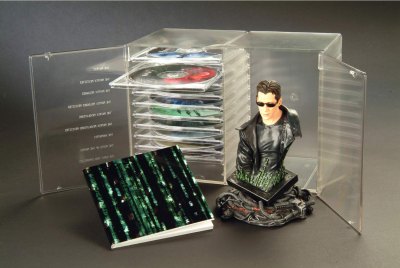
THE PACKAGING
The packaging for the Ultimate Matrix Collection: Limited Edition carries with it a definite coolness, but the construction is rather flimsy. The discs are stacked in a clear-plastic box, which is labeled elegantly but feels on the cheap side. You slide discs out on thin plastic trays. On the other side of the box is a very well-designed and finely painted Neo bust. Behind the box is a glued-on paper representation of the raining Matrix code, but my copy was marred by one of those damned security stickers. (Why couldn't they affix the sticker to the plastic box, so that it could be easily removed?)
The included booklet has a terrific metallic-green 3-D cover. It includes a reprint of the Written Introduction by the Wachowski Brothers, which also appears on Discs 1, 3, and 5. The rest of the book is devoted to outlining the DVD contents, along with production and behind-the-scenes photographs, conceptual art, and trivia.
Is the packaging worth the extra 50 bucks? Well, let me tell you: It looks awfully cool on my shelf. Isn't that all that matters?
THE VIDEO PRESENTATION
Warner presents The Matrix saga in terrific anamorphic-widescreen transfers of the films' original 2.35:1 theatrical presentations. The biggest image news in the Ultimate Matrix Collection is the creation of a brand-new, sparklingly clear transfer for the original film, which originally debuted on disc during the early days of DVD. Although the image was excellent for its day (going on 5 years ago), looking at it from the perspective of 2004—at a time when our standards have risen and our eyes have become more demanding—reveals an aged appearance. Grain is unnecessarily heavy, and a certain dimness prevails, affecting fine detail and depth.
The new Matrix image is quite different from its previous incarnation, not only in its added levels of depth and detail but—more controversially—in its slight modification from the original theatrical look toward a solid visual style that more closely resembles that of the sequels. The Matrix Reloaded and The Matrix Revolutions amped up the green-tinting of the scenes taking place within the matrix and added a more pronounced tinting of blue to real-world scenes, as well as a glowing gold to represent the spiritual. This new effort on the original film's look, supervised by the Wachowskis and director of photography Bill Pope, has applied the same color palette to the film's timing—to the consternation of some diehard fans. Frankly, those who are complaining about the new look are probably forgetting the fact that the original film already did have the green tinting. It's only been marginally elevated in the interest of stylistic consistency.
But, damn, is this a good-looking transfer! I have absolutely no problem with the subtle differences in color, as they give the saga a splendid visual harmony and, more important, the new transfer gives the first film a striking cleanliness and sharpness that renew your appreciation for the Wachowskis' unique visual handiwork. Detail is absolutely fine and filmlike, and the image attains a pleasing depth with its inky blacks, measured contrast, and colors that are perfectly and consistently in service of the new palette. I noticed the appearance of some slight natural grain, and I noticed some very minor ringing on hard edges.
OLD:
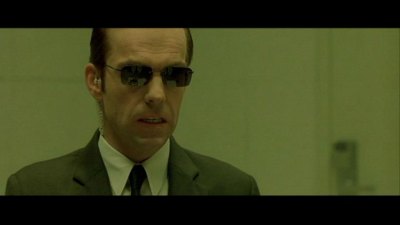
NEW:
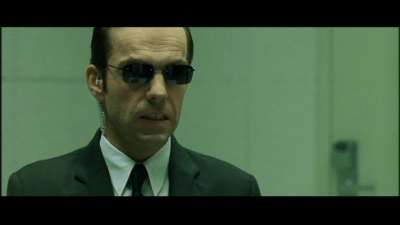
OLD:
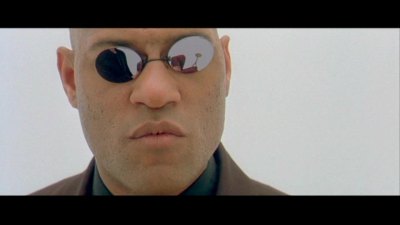
NEW:
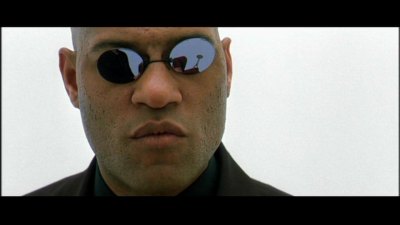
OLD:
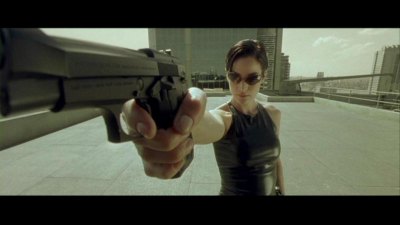
NEW:
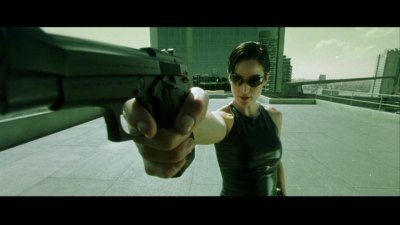
OLD:
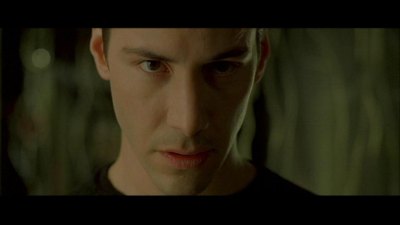
NEW:
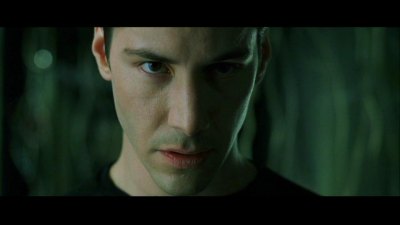
The Matrix Reloaded and The Matrix Revolutions are presented in the same transfers that graced their originally released DVDs. Which is to say that they're both reference-quality, providing images of peerless depth and sharpness with little in the way of digital enhancement or noise.
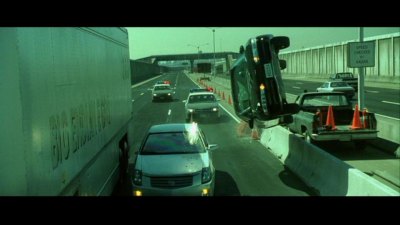
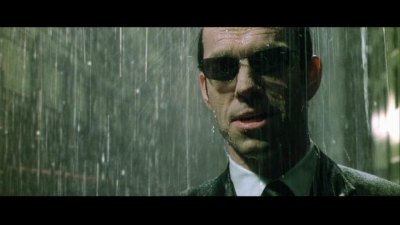
THE AUDIO PRESENTATION
For all three films, the set provides excellent—if not perfect—Dolby Digital 5.1 audio presentations. Let's talk about the good first. The Matrix DVDs are already established as reference-quality DVDs, boasting very aggressive soundtracks with wide-open soundfields and sensational attention paid to directional sound. These are immersive experiences, mirroring the theatrical soundfield in their envelopment (that is, if you saw the films in excellently equipped auditoriums). When you pay close attention to the front soundstage, you notice a seamless sense of panning combined with clear, natural, even rich effects and vocals. (Regarding vocals, see below for a related complaint.) Attention to fine sound detail is admirable, and the lack of annoying laser-focused directionality is refreshing. Diffusion of appropriate information into all channels puts you right in the midst of the action without sounding gimmicky. The score comes across especially well, with a terrific low-end oomph that also benefits the more resonant effects.
I need to pay special attention to the surround activity. Tour the back of your room with these soundtracks blaring, and the sense of envelopment isn't lost. As you're aware, the Matrix films are filled with action that comes from all directions. They're bursting at the seams, particularly in the sonic realm. The films' many action sequences swirl around you, effects panning past you fluidly and Don Davis's score thrumming from a central location within the room.
The bad news is that, like many recent DVDs and even CDs, dynamic range sounds compressed, thanks mostly to faulty mastering. Although the low end has a terrific, vibrating resonance, the powerful bass is often at the expense of mid-level detail such as, you know, dialog. I found myself frequently forced to crank the volume of these soundtracks 10 decibels beyond my usual reference level to get adequate richness in the midrange. I doubt the presence of DTS would have significantly improved the problem, as the engineers responsible would probably have applied the same grievous overcranking in mastering.
Each film offers English and French 5.1 tracks (the French tracks are dubbed in Quebec). You can access English, French, and Spanish subtitles.
THE SUPPLEMENTS
This set's exhaustive extras span all 10 discs, providing about as comprehensive an education about the making of—and meaning behind—the Matrix films as possible within the limitations of the DVD format. I have just come away from a many-hours study of the video, text-based, and still-frame supplements contained herein, and I'm quite happy to say that there's very little actual redundancy going on. We do get some repetition of ideas here and there, but they're presented in different contexts or from different points of view. One of the more enticing aspects of these supplements is the effort on the part of the Wachowskis and the DVD production team to provide a balance of the self-reverential and the critical, embodied primarily in the dual commentaries—themselves acting as a sort of yin and yang—that you'll find over each of the films in the trilogy.
That being said, The Ultimate Matrix Collection gives rise to inevitable complaints. Several previously available features are repeated here, and if you already own them, you're probably going to feel some frustration. Foremost among the redundancies are The Matrix Revisited (which is Disc 2 here), The Animatrix (which is Disc 7 here), the video and audio presentations of The Matrix Reloaded and The Matrix Revolutions, and some of the supplemental footage in the Revisited discs for those two films. I don't deny that those are marks against this set, but the sheer comprehensiveness of the set really does demand the attention of the DVD geek and any fan of The Matrix.
More complaints: There were several times, while clicking through documentaries and short featurettes, when I perceived a certain lack of organization or focus, as if the producers had such a monumental amount of material to work with that they often had trouble putting it in order. Particularly on the three Revisited discs (discussed in detail below), I felt a certain frustration that certain major aspects of the production were given cursory attention—say, in a montage sequence—whereas a relatively minor detail or sequence got micro-detail attention. Or a certain action sequence would receive superficial attention, and only here and there in various featurettes would its specific facets receive more focused attention. There's a randomness to the special features that becomes a bit confusing.
I was also a tad disappointed to see that 95 percent of the video features are presented in full-frame. The immediate contrast to be made with this set is the Return of the King Extended Edition DVD, which—like its predecessors—boasts 1.85:1 anamorphic-widescreen supplements. I can't help but feel a tinge of regret that this set doesn't provide the same attention to the tech geeks among us. I realize that most supplemental footage is shot with 4:3 video cameras, and to accomplish widescreen in such instances, you'd have to crop the image, resulting in lost resolution. But at the same time, I feel real gratitude when a set goes to the extra effort of enhancing its extras. Also, I was frustrated by the fact that the video elements offer no skipping ability, giving the menu navigation an unintuitive quality.
But don't let my quibbles give you the idea that I'm not appreciative of the exhaustiveness of this amazing set. The Ultimate Matrix Collection completely lives up to its title, assembling perhaps every known scrap of behind-the-scenes footage and art, as well as creating captivating supporting material, all in the effort of immersing you fully in the world of The Matrix. Let's walk through the voluminous extras piece by piece.
Disc One: The Matrix
The first supplement you come to on Disc 1, under the Commentaries section, is a Written Introduction by the Wachowski Brothers, spanning about a dozen screens, in which the brothers write—somewhat snarkily and in satirically high-falutin language—about the origins of The Matrix, which they call "a chop-socky flick that comments on the Hegelian dialectic while having a guy who can fly and stop bullets." They also take a moment to comment on why they won't talk about their films, and use their reasoning as a justification for this set's included commentary tracks, which are the next items you come upon in this set.
The Wachowskis envision these two saga-spanning commentary tracks—one from a philosopher duo who enjoy and appreciate the films and another from a group of critics who do not—as complementary in the sense that the juxtaposition of perspectives inherent in the dichotomy creates an implied dialog. It's a fascinating idea that works beautifully in theory, but let's see how it works in "the real world."
The commentary labeled The Philosophers: Dr. Cornel West & Ken Wilber is extremely rich and layered, and it's by far the more involving of the two tracks (at least for this Matrix explorer). Although you'll notice a fair number of silent spots, you really won't mind, because they give you a cerebral break between long strings of powerful thoughts spanning religious allegory, philosophical influences, and mythological structure. It would be easy to dismiss some of these explorations and tangents as mind-scraping gobbledy-gook, and certainly they require you to be open to meaning and willing to accept The Matrix films as something far more than science-fiction action flicks. As these two learned men—who, admittedly, are completely immersed in the philosophical foundations of the films and somewhat blind to the arguably more important functionality of all three films as movie narratives—point out, The Matrix is a many-layered, endlessly curious, resonant work of pop philosophy, rich of meaning and always unraveling in unpredictable ways. I'm inclined to agree, the more I delve into these films' underpinnings, but the question of whether the Matrix films as a whole are successful as films is another question—and one that becomes increasingly important as we move toward the third film. Nevertheless, this is an endlessly fascinating track, if your mind is open to it.
The track labeled The Critics: Todd McCarthy, John Powers & David Thomsen—presents a conversation that's much more likely to annoy you. McCarthy (Variety), Powers (Vogue), and Thomsen (The Biographical Dictionary of Film) make up a catty, name-dropping group prone to summoning the specters of Cocteau, Godard, and film noir, and letting significant dead spots go by, but nevertheless, this track provides a satisfactory counterpoint to the philosopher track, exploring the arguably more essential role of these films as films rather than merely conveyors of resonant ideas. There's definitely a barrier that you must get past here: These critics, assembled into something of a circle-jerk, project the sense that their noses are lifted in film-school superiority, particularly at the start of their conversation. But they do loosen up as the track progresses, and their points are well-taken. Although they have more praise for the first film than not (and in fact end up just watching and appreciating a lot of it), their thoughts about the telling-instead-of-showing nature of the narrative begin here, and I found myself almost reluctantly agreeing with these three. And really, their conversation becomes more involving as we get into the commentaries for the sequels.
Missing from the original Matrix DVD release are several noteworthy special features, including a Commentary by actress Carrie-Anne Moss, visual effects supervisor John Gaeta, and editor Zach Staenberg (no big loss), a good Making of the Matrix featurette, and an Isolated Score by Don Davis track. However, some of the material from the featurette, as well as the well-known easter eggs, finds its way onto the following disc.
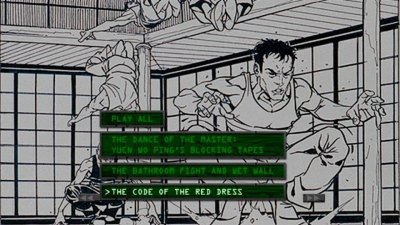
Disc Two: The Matrix Revisited
The 2-hour-and-2-minute The Matrix Revisited documentary is the same documentary that was previously available as a standalone disc. This is an utterly exhaustive and almost nostalgic behind-the-scenes look at the making of the first film from the perspective of beginning work on the much-higher-budgeted sequels. It starts in November 1997, sixth months prior to principal photography, and ends in 2000 as rehearsal for the sequels begins. It features generous contributions from the Wachowskis, producer Joel Silver, director of photography Bill Pope, conceptual designer Geof Darrow, visual effects supervisor John Gaeta, production designer Owen Paterson, editor Zach Staenberg, kung-fu choreographer Yuen Wo Ping, actors Keanu Reeves, Hugo Weaving, Laurence Fishburne, and Carrie-Anne Moss, and many more. It's fun to hear the Wachowskis defend their film by saying, as if drugged, "We like kung-fu movies," then segue into the film's origins in Baudrillard's Simulacra & Simulation, a book that actually has a cameo in the film. There's a lot of talk about how now many people—particularly the studio types—just "didn't understand" the concept and the film, and about the Wachowskis efforts to make people understand. Those efforts include elaborate storyboards and conceptual art, and the contributions of Geof Darrow. We then move through set construction and costuming, training ("Kicked my ass," says Fishburne), and actual shooting of several key scenes in Australia (including a scary injury to Moss's ankle), shooting and blocking of several fight sequences ("How we trained and how we filmed were two different things," says Reeves), post-production, the innovative work of the two visual effects companies that contributed to the film, the creation of Don Davis's score (with contributions from both Davis and music supervisor Jason Bentley), and the reaction among the cast and crew to the finished film ("Morpheus scared the shit out of me," says Fishburne). It ends with a brief preview of the sequels. One conclusion after watching this documentary: Andy Wachowski plays with his shoes and goatee a lot. You can watch The Matrix Revisited in one long chunk (that's longer than the actual film), or you can watch it in pieces, thanks to a Chapter Selection screen.
The Music Revisited, which was an easter egg on the original disc, provides 41 tracks of music used in The Matrix.
- Aleks Svaensson "Syvelleve"
- da nu lo "I'm not right (I'm what's left)"
- Gooding "Licorice and Grape Kool Aid"
- Jetsetmusic "Last Laugh Foundation Part C"
- Obadia "Lounge"
- Obadia "Slowride"
- Omniverse "Hipshot"
- The Fur Ones "Semicolon"
- Robert Phoenix "Speedy Astronaut"
- Canton "Birmingham, 43"
- Electrostatic "Electron Gun"
- Ikarus "Praying to different gods"
- Nolens Volens "Por sea T"
- Out of Body "Beyond Mind"
- Paul Cooper "CEM2 New Stuff"
- Proactive Noize Transmission "One foot freak"
- Project 3 "Go get it"
- VOID "Chemical 2000"
- Audible Ink "Dand Turtle"
- O.R.G. "Sofa Surfer"
- Simulcra "Spy vs. Spy"
- Wade R "Squarely in the groove"
- Audible Ink "Beetle Instrumental"
- Beat T Tribe "Beat T Tribe (slight return)"
- Fingertwister "7a.m. Disaster"
- Hardknox "Coz I can"
- Aleks Svaensson "Art of Recycling"
- Canton "Blue Groove"
- Fingertwister "Casino Royale"
- Aleks Svaensson "Sunny"
- Fingertwister "In Memory Of…"
- Less Skill "Technical Difficulties"
- Simulcra "Panacea"
- Fingertwister "The Reverend Will Return"
- O.R.G. "Traveling Man"
- Project 3 "The Search"
- Tripnotic "Tripnofunk"
- The Fur Ones "Transit"
- The Fur Ones "Product"
- The Fur Ones "The End"
- The Fur Ones "Reduction"
Under Behind the Matrix, you get six featurettes, totaling 18 minutes if watched with the Play All function.
- Dance of the Master: Yuen Wo Ping's Blocking Tapes (6 minutes)—Two stunt fighters enact Neo and Morpheus's Dojo fight for choreography purposes.
- Bathroom Fight and Wet Wall (3 minutes)—Cast and crew discuss a pivotal escape sequence.
- Code of the Red Dress (1 minute)—Costume designer Kym Barrett talks about the phenomenon of the woman in red.
- The Old Exit: Wabash and Lake (3 minutes)—A collage of behind-the-scenes footage from the end-of-film foot chase and hotel fight between Neo and Smith, along with brief interview footage with the Wachowskis, Keanu Reeves, Laurence Fishburne, and Hugo Weaving.
- Agent Down (2 minutes)—A look at an injury that Hugo Weaving endured while rehearsing fights. The Wachowskis, Keanu Reeves, and Laurence Fishburne make appearances.
- But Wait—There's More (3 minutes)—An entertaining compilation of behind-the-scenes footage of several key action sequences.
Under Take the Red Pill, you get two featurettes, adding up to 17 minutes if watched with the Play All function.
- What Is Bullet-Time? (6 minutes)—Special effects supervisor John Gaeta explains how the movie's groundbreaking multiple-camera slow-motion action-tracking shots were achieved. The erector-set quality of the green-screen set is itself a work of art.
- What Is the Concept? (11 minutes)—An abstract look at the liquid-mirror effect that precedes Neo's entrance into the real world, then follows him into the pod. We see the original concept art, storyboards, and preliminary and finished special effects, and over all of it is finished dialog from Neo and Morpheus. We also see design work and sketches for the Nebuchadnezzar and the Sentinels.
Under Follow the White Rabbit, you get nine terrific fly-on-the-wall, narration-free featurettes, totaling 23 minutes if watched with the Play All function.
- Trinity Escapes (1 minute)—We see the making of the hotel-room fight and Trinity's rooftop sprint.
- Pod (2 minutes)—We glimpse the creation of Neo's escape from the gelatinous pod.
- Kung Fu (4 minutes)—Chronicles the making of the Dojo fight scene.
- Wall (2 minutes)—This featurette shows the making of the scene in which our heroes escape the Agents between narrow walls.
- Bathroom Fight (2 minutes)—Laurence Fishburne and Hugo Weaving get down and dirty.
- Government Lobby (4 minutes)—As you might expect, this making-of featurette contains a lot of goddamn gunfire.
- Government Roof (2 minutes)—Shows the making of the legendary fight scene on the roof, including Neo's bullet evasion, as well as the later helicopter rescue of Morpheus.
- Helicopter (1 minute)—This piece shows the model work for and the shooting of the highrise-crash sequence.
- Subway (4 minutes)—This one chronicles the making of the climactic underground fight sequence between Neo and Smith.
This disc is different from the original release. It contains a wealth of new featurettes but also drops a few. Missing are the short What Is to Come?, What Is the Animatrix?, Whatisthematrix.com?, and The True Followers featurettes.
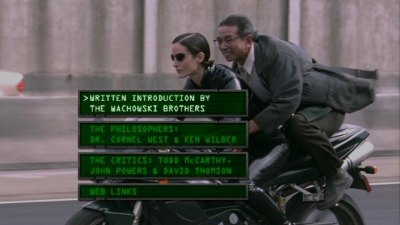
Disc Three: The Matrix Reloaded
As with Disc 1, the first extra on Disc 3, under the Commentaries section, is the same Written Introduction by the Wachowski Brothers, so here's an alarming bit of repetitiveness that I hoped wasn't a foreshadow of redundancy to come. (Fortunately, it wasn't.) I suppose the introduction is here for those who might eventually buy these discs individually, outside the set.
We get a second installment of the commentary labeled The Philosophers: Dr. Cornel West & Ken Wilber, and this is a terrifically enriching track when you consider that Matrix Reloaded plays even more deeply with meaning than the first film—sometimes to the detriment of the top-level storytelling. In a way, this track comes across as more of an intellectual defense of the sequel, because both men understand that both sequels met with less-than-enthusiastic public reception. One of the great discussions of this track regards the complex, symbiotic relationship between Neo and Smith. But even more important to both Reloaded and Revolutions is the role of Eros and pure love, which the men discuss at length throughout. We also get a whole new, deeper understanding view of Neo "doing his Superman thing" when we consider Nietzche's notion of the superman rather than the comic-book notion. The Rave sequence is celebrated—as it should be—as a necessary celebration of the body before the confrontation with the machines.
The second installment of The Critics: Todd McCarthy, John Powers & David Thomsen track is when these holier-than-thou boys (still name-dropping) really begin criticizing. In that way, they're acting as the voices for the many critics of the sequels, decrying the films' increasing reliance on philosophical and religious underpinnings and doubting that many of the meanings the Wachowskis were going for actually work in the film. They call the religious imagery and symbolism "oppressive" in the context of the narrative, and as far as the narrative is concerned, they call the dialog wooden and the story filled with self-conscious, masturbatory references. On and on, they criticize the proceedings, calling attention to flaws as compared with the perfection of the first film. You can often hear their derisive laughter at patches of dialog. They call the Rave scene a hilarious, boring, beer-commercial, Joel-Silver, multicultural disco scene. At the same time, they'll describe certain passages of dialog as poetic, and some of the imagery as artistic. I find it very telling that these critics fail to acknowledge the Nietzchian element of the superman in Neo's ascendance and instead just complain about the dredging up of another comic-book superhero. There's definitely the sense that even though they have some valid points about the movie as a movie, they're missing the intended scope. After listening to both commentaries on this disc, you gain a real appreciation for the inclusion of these polar-opposite tracks and the effect they have on your understanding of the films and their strengths and flaws.
Missing from the original Matrix Reloaded DVD release are several supplements, including featurettes called Preload, The Matrix Unfolds, The Freeway Chase, Get Me an Exit, and The MTV Movie Awards Reoladed. However, some (but not all) of the material from the featurettes finds its way onto the following disc.
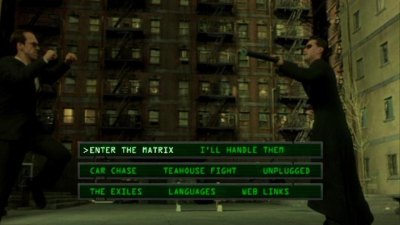
Disc Four: The Matrix Reloaded Revisited
The Matrix Reloaded Revisited disc differs from the first Revisited disc in that it provides a series of shorter featurettes rather than one lengthy documentary. My preference, given the somewhat disconnected nature of what follows, would be for the long documentary, but that's a personal choice.
The 42-minute Enter the Matrix featurette offers film footage that you might not have seen before, unless you've played the Enter the Matrix video game. This was mostly footage that the Wachowskis shot specifically for the game, and it offers story and character development that expand the Matrix universe. This featurette begins with a short 1-minute introduction in which Joel Silver, Jada Pinkett Smith, and Anthony Wong (Ghost) talk about the background of the Enter the Matrix video game and how the experience of the game is incorporated into the world of the film. Presented in non-anamorphic widescreen and Dolby Digital 2.0 are, in order of appearance within the game, as follows:
- Niobe and Ghost Jack In
- Last Transmission of the Osiris
- 72 Hours
- Hallway & the Keymaker
- A Kiss From Niobe (wheeee, Jada Pinkett Smith smooches Monica Belucci, then tells her that her true love's name is Jason! Cool!)
- A Kiss From Ghost (the same scene but with Ghost, except he doesn't profess his love for me)
- Clean Exit
- The Logos Returns to Zion
- Lock & Niobe
- Ghost & Trinity Pt. 1
- Ghost & Trinity Pt. 2
- Lessons of the Oracle (cool fight sequence)
- Off to the Freeway
- Sparks Directs Traffic
- Saving Morpheus
- Three Hours to Attack
- EMP Aftermath
- Niobe Visits the Oracle
- Ghost Visits the Oracle
- Niobe Leaves the Oracle
- Ghost Leaves the Oracle
- "Picnicking Sentinels"
- One Hell of a Ride
The I'll Handle Them section, which totals 17 minutes if watched with the Play All function, studies the filming of the Merovingian Chateau fight sequence.
- The Great Hall (5 minutes)—A look at the challenges of choreographing and designing the fight sequence in the chateau.
- Building the Merovingian's Lair (5 minutes)—A peek into the creation of and European influence on the design of the set.
- Tiger Style: A Day in the Life of Chen Hu (4 minutes)—This piece talks about the career trajectory of this young stuntman/actor, including his work on both the first and second Matrix films.
- Heavy Metal: Weapons of the Great Hall (3 minutes)—Special-effects supervisors and stunt players talk about the many, many rubber weapons created, and how they were imagined or researched.
The Car Chase section, which totals 55 minutes if watched with the Play All function, studies the intricate freeway chase in micro-detail.
- Oakland Streets and Freeway: Unseen Material (10 minutes)—This piece talks in general terms about the making of the freeway sequence, from the construction of the gigantic set to the recycling of the lumber for housing in Mexico. There are no deleted scenes here, as the title suggests, but rather a collage of behind-the-scenes interviews and footage, along with pre-viz enactments and other choreography. Watch for a cool WD-40 trick.
- Tour of the Merovingian's Garage (2 minutes)—Here's a quick look at the cool cars in the garage, where the fight with the Twins take place, and how a couple of the cars were abused in the sequence.
- Queen of the Road (3 minutes)—A look at stunt player Debbie Evans, Trinity's stunt double atop that against-traffic motorcycle. Amazing work!
- Arteries of the Mega-City: The Visual Effects of the Freeway Chase (12 minutes)—Now we're starting to delve more deeply into the detail of the sequence. This piece begins with a look at the digital and painted cityscape backgrounds, then moves on to the ghostly effects of the Twins and the possession effects of the Agents. It ends with a look at the CG elements of the truck-top fight. There's a spectacular computer-effects shot here that I assumed was live-action.
- Foresight: Preplanning the Mayhem (6 minutes)—Here's where we learn how the freeway sequence was extensively previsualized. It's more of a general look at previz techniques than a detailed look at the digital choreography of the freeway scene. Scenes from throughout the series are included here.
- Freeway Truck Crash: Anatomy of a Shot (5 minutes)—This is a fascinating look at the creation of the semi crash, beginning with intricately detailed Geof Darrow conceptual art, working through digital previz, and ending with the escalation of the CG shot. There's some hilarious and disturbing footage of digital facial captures of the actors' faces.
- Fate of the Freeway (2 minutes)—We get a closer look at the destruction of the freeway set and the recycling of the materials in Mexico for low-cost housing.
- Freeway Action Match (14 minutes)—Here's a terrific dual-screen look at the finished footage of the entire freeway chase compared with conceptual art, storyboards, previz enactments, and behind-the-scenes footage. I found this succinct compilation of footage to be totally fascinating.
The Teahouse Fight section, which totals 7 minutes if watched with the Play All function, takes a brief look at the tabletop fight between Neo and Seraph.
- Two Equals Clash (4 minutes)—Actor Collin Chou (Seraph) talks about how important it is to him that this first filmed fight scene takes place in a Chinese teahouse, in a classical sense. Then we walk through the choreography of the fight.
- Guardian of the Oracle: Collin Chou (3 minutes)—Here we get to talk some more with Chou, who seems a genuinely interesting person, much like his character. He talks about his history in Chinese films as well as his own interpretation of Seraph.
The Unplugged section, which totals 40 minutes if watched with the Play All function, takes a detailed look at the wildly over-the-top fight sequence between Neo and a hundred Agent Smiths.
- Creating the Burly Brawl (17 minutes)—"There are more movements in this fight than in the whole first Matrix," says Keanu Reeves. "It might actually be double." Just watching this study of the choreography of this fight leaves you slack-jawed, trying to get your brain around the complex logistics of it. Watch for a great shot of square CG Hugo Weaving face-captures affixed to the bodies of stunt doubles, as well as a CG "Proof of Concept" segment that shows a lot of fun (and some unused) fight movements. A significant period of time is spent on the creation of the set, which is quite elaborate. And then we go into the CG-animation elements of the fight, and even though the effect in the final film isn't quite perfect, you have to admire the lengths to which this crew went to make it real—including the way light plays on different kinds of cloth and on the entire scene at any given moment.
- A Conversation with Master Wo Ping (10 minutes)—In this subtitled interview, Ping gives us biographical details about his life and career, and quickly gets into his experiences with the Wachowski brothers on the Matrix films. He takes time to acknowledge the other members of his martial arts team, pointing out their strengths. He talks about how he determined the styles of fighting he would use in the films. Much behind-the-scenes footage is included here, and it becomes a rewarding look at the fight choreography in Reloaded, particularly the Burly Brawl and the Chateau fight. Cool guy.
- Chad Stahelski: The Other Neo (2 minutes)—Here's a brief look at the work of Keanu's stunt double throughout the Matrix films. He was also in charge of the training facility and the martial arts stuntwork. Fun quote: "Chad seems to hit a lot of people. A lot of people around here say good things about him, but he hits a lot of people."
- Burly Brawl Action Match (6 minutes)—Similar to the Freeway Action Match above, this is a great, insightful dual-screen look at the finished footage of the entire courtyard fight compared with conceptual art, storyboards, CG progression, and behind-the-scenes footage. There's more live-action footage here than I suspected. These are excellent supplements, probably my favorite on the Revisited discs.
- Spiraling Virtual Shot: Anatomy of a Shot (5 minutes)—This is a detailed look at a CG shot in the Burly Brawl in which the camera drops down toward the courtyard as a legion of Smiths attack Neo in a sort of hurricane formation.
The Exiles section, which totals 18 minutes if watched with the Play All function, gives you a good look at the various "exile" characters in Matrix Reloaded.
- The Exiles (9 minutes)—From the perspectives of the actors who play them, these are background snippets on the various exile characters, including the Merovingian, Persephone ("Like a vampire, but instead of blood, she sucks emotions," says Monica Belucci), the Twins, the Keymaster, Sati (from Matrix Revolutions), and the Trainman (also from Revolutions). I actually learned quite a bit about the Wachowskis' intentions just by listening to these backgrounds. And the infectious joy of Randall Duk Kim (the Keymaker) for taking part in the film makes this one of the must-see featurettes in the set.
- Big Brother Is Watching: The Architect's Office (8 minutes)—This examination of the architect's lair surprised me with the sheer amount of green-screen involved. I had assumed it was at least a partial set. Actor Helmut Makaitis admits to doing a "cheap Orson Welles impression" for the Architect, and describes the 3-day shot as "hell." We also get a look at the shooting of all those different Neo facial expressions and screams and curses recorded for the separate screens.
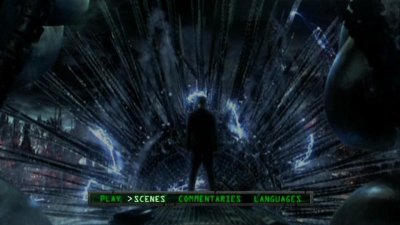
Disc Five: The Matrix Revolutions
As with Discs 1 and 3, the first extra on Disc 5, under the Commentaries section, is the same Written Introduction by the Wachowski Brothers.
The third installment of The Philosophers: Dr. Cornel West & Ken Wilber commentary begins with West declaring there's "nothing like these films in American or world culture." The philosophers maintain that you really have to read or interpret the Matrix trilogy as a whole to truly understand it. You probably wouldn't want to jump straight into this third philosophers' track before listening to their thoughts over the first two films, because there's a definite progression to both the saga and this rich, continuing discussion of it. Also, because Revolutions is the most inner of the three films, the most focused on meaning, the most removed from the traditional sci-fi action template, their discussion of this film is arguably the most involving, simply because every intellectual facet of the entire saga obviously culminates here. The most interesting aspects of this track, for me, involve the discussions of Neo and Smith as yin and yang—as opposites who must ultimately become one—as well as the importance of Neo's connection with Trinity. West calls modern critics just "too lazy" to appreciate the sequels for what they're offering.
The third installment of The Critics: Todd McCarthy, John Powers & David Thomsen commentary continues these guys' diatribe against the dramatic elements of the story. Although in the case of Revolutions I fall more on the side of the critics than the reverential philosophers, I can still manage to fit my opinion of the story firmly between the two poles of thought. In a way, these laughing critics come across as surface-oriented, blind to deeper meaning, and that becomes tiring, particularly if you've first listened to the philosophers and gained a deeper appreciation for what the Wachowskis have attempted. But there's no denying at all that Revolutions, much more so than Reloaded, suffers from a lack of character focus and narrative sense, and that's what these guys focus on. I find it interesting that one of the critics, at one point, admits that there are surely people who could explain the films' meaning to them in detail. Perhaps they need to listen to the other commentary—and vice versa.
Missing from the original Matrix Revolutions DVD release are several supplements, including featurettes titled Revolutions Recalibrated, CG Revolution, Super Burly Brawl, Before the Revolution, and 3-D Evolution. However, some of the material from the featurette, as well as the well-known easter eggs, finds its way onto the following disc.
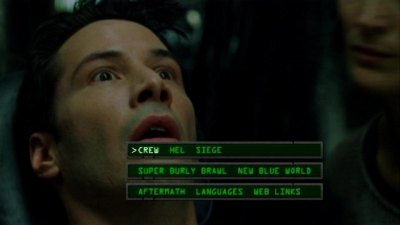
Disc Six: The Matrix Revolutions Revisited
Similar to The Matrix Reloaded Revisited, this disc brings you a series of featurettes rather than one long documentary. More people-focused than the first two Revisited discs, this one really gives you a deep appreciation for the Herculean efforts of the craftsmen and craftswomen involved in the production.
The Crew section, which totals 25 minutes if watched with the Play All function, gives you generous peeks at the guys and gals behind the scenes, the people with the typically thankless jobs.
- Owen's Army: The Australian Art Dept. (4 minutes)—Here's where we meet the Down Under team that works with production designer Own Paterson. They're a group with a lot of character.
- 2nd Unit: A World of Their Own (6 minutes)—We get a glimpse of the type of work usually relegated to the second-unit team. In the case of the Matrix movies, it looks like it's a lot of blowing stuff up. And shooting inserts. Also, there are some cool shots of Trinity falling.
- Bill Pope: Cinematographer of the Matrix (8 minutes)—This is both a biographical and behind-the-scenes look at Pope, liberally sprinkling the proceedings with clips from the making of Reloaded and Revolutions. He talks about the challenge of filming the two films back-to-back, which amounted to 270 scenes. That's a lot. We also get a glimpse of a cameo he has in Reloaded.
- Masters of Light and Shadow (7 minutes)—Here's an illuminating (sorry) look at the dudes in charge of lighting and the movement of the cameras.
The Hel section, which totals 28 minutes if watched with the Play All function, offers a look at the strangely derivative Club Hel sequence, which nevertheless offers some innovations, as you'll see.
- Coat Check (5 minutes)—A peek at the making of the anti-gravity fight scene before the meeting with the Merovingian. The most interesting aspect of this piece is the solution to the challenge of putting running stuntmen on the ceiling without turning the set upside-down.
- Upsidedown Under (5 minutes)—And now here's an even closer look at the upside-down effects alluded to in the previous featurette. "These guys are crazy," says Carrie-Anne Moss, referring to the men who did the stunt. The devices used for the effect are really quite innovative.
- Fast Break (6 minutes)—This is a look at the film's physical effects, such as breakaway walls, disintegrating pillars, large-scale destroyable models, and pyrotechnics.
- Exploding Man (5 minutes)—This is a profile of Leo Henry, the head of pyro effects and explosions. He shows off his various explosive wares.
- Gun Club (2 minutes)—Here's a look at the weapons the main characters use in the Club Hel sequence. Most of them are outlawed in Australia, where filming took place. There are a lot of damn guns in this piece, as well as the men who love them.
- The Extras of Club Hel (5 minutes)—This is a somewhat scary and weirdly kinky glimpse at the extras who were brought in to take part in this odd sequence. Most were wearing their own costumes.
The Siege section, which totals 40 minutes if watched with the Play All function, is a detailed examination of the film's ridiculously elaborate machine attack.
- Dig This (10 minutes)—First up is a rather fragmented look at many of the effects that went into the sequence, including motion capture, miniature work, practical effects, set design, conceptual art, animatics, carpentry, lighting, painting, and so on. This piece seemed as chaotic as the battle itself, when I'd rather have seen a more focused discussion on certain aspects. It's almost as if there was so much going on in the sequence that they didn't know where to begin showing us how they did it. Fun quote: "Everything we make, we blow up."
- The Siege Action Match (10 minutes)—Like similar features on the first two Revisited discs, this one is a fascinating dual-screen look at the making of the sequence, comparing the finished film with storyboards, early CG, model work, and behind-the-scenes glimpses.
- Anatomy of a Shot: Mifune's Last Stand (5 minutes)—John Gaeta returns with a look at a freedom fighter "deeply, deeply in the shit," as he says. He shares storyboards, previsualizations, matte paintings, green-screen originals, and digital captures for an extremely detailed look at the shot.
- Building an APU (5 minutes)—Here's a look at the concept and design of the large, robotic fighting mechanisms that Zion uses against the machines. We see both the physical effects in front of the green screen and the CG effects that made them come alive.
- Product of Zion (10 minutes)—Harold Perrineau (Link), Nona Gaye (Zee), Rachel Blackman (Charra), Harry Jlennix (Commander Lock), and Nathaniel Lees (Mifune) talk about their excitement to be a part of the Matrix saga, as well as their approaches to their roles. Gaye talks about her feelings about replacing Aaliyah, the late actress/singer who had been previously cast in the role of Zee.
The Super Burly Brawl section, which totals 17 minutes if watched with the Play All function, is a look at the final battle between Neo and Smith, which takes place in "chubby rain" and spans the sky. Frankly, I felt that this section didn't dive quite deeply enough into an important sequence.
- The Sky Barn (5 minutes)—The name of this piece refers to the elaborate set in which the scene takes place. This particular segment focuses on a breakaway-wall shot and a high-kick shot that used both practical and visual effects.
- The Crater (5 minutes)—This is an absolutely drenched look at the water-logged end-of-fight sequence that takes place in the crater-pond. From the sound of it, the actors weren't too fond of the conditions. There's an interesting piece of trivia in this one that I won't reveal.
- The Egg (3 minutes)—Now we get into the sky-borne fight between the two men and see the rigs that lifted the actors into the sky. One rig was called "the egg," even though it was more like a half-box.
- Anatomy of the Superpunch (4 minutes)—John Gaeta returns for a look at the face-distorting punch that Neo delivers to Smith. Starting with concept art by Geof Darrow, he walks through the motion-capture reference material, previsualization, and blue-screen captures, and talks about the influence of the Fight Club shot in which Ed Norton shoots a bullet into his own face. This is a terrific, intricate look at a humorous shot.
The New Blue World section, which totals 26 minutes if watched with the Play All function, feels like a kind of "miscellaneous" section, holding featurettes that didn't fit well in the exisiting categories.
- Geography of Zion (9 minutes)—This piece discusses the physical and psychological makeup of Zion. The crew talks about how it contrasts with the world of the matrix, and the cast admires the multicultural aspects of its inhabitants. We get a virtual tour of the entire subterranean city, and we get a look at the construction of the sets. Interestingly, the design of the living quarters is reminiscent of the slave pods of the first film.
- The Ships (6 minutes)—This quickly edited piece on the ships of Zion is pretty cool. I enjoyed Geof Darrow walking us through design concepts and sharing CG models.
- Tour of the Neb (3 minutes)—This is a video tour of the Nebuchadnezzar, hosted by Owen Paterson.
- Matrix TV (5 minutes)—This is a peek at the creation of onscreen graphics that appeared on the film's various monitors.
- Logos Fight Expansion (3 minutes)—Here's a glimpse of the filming of the fistfight between Neo and Bane/Smith.
The Aftermath section, which totals 40 minutes if watched with the Play All function, discusses a few of the sequels' post-photography elements.
- Revolutionary Composition (9 minutes)—This look at Don Davis's score starts with a bang, in a percussive scoring session. Davis talks about his approach to certain themes, and we even get to hear the individual input of some of the musicians. His contributions to the Animatrix shorts are discussed, particularly Final Flight of the Osiris. Most interesting is the segment about the choir, which is singing significant passages from the Upanishads in the original Sanskrit.
- The Glue (7 minutes)—This is a profile of editor Zach Staenberg. He's interviewed just at the end of principal photography for the two sequels, so his job is just beginning, and he's all excited about what lies ahead.
- Dane Tracks (7 minutes)—Here's a look at the work of sound designer Dane Davis. There's some great footage of capturing the sound of crashing junker cars, but mostly he talks about what he used for certain sound effects rather than showing us. This could have been a better look at the real-world sound sources.
- Cause and Effects (16 minutes)—This is a look at the various special-effects houses—Giant Killer Robots, Buf, Tippet Studios, and ESC Entertainment—that were involved with the films' CG and other effects shots. We get a little profile of each house and see what elements each worked on. The look at the making of the matrix-orgasm was enlightening. Also, we get more detail about ESC's capture of actors' facial expressions for use on digital characters.
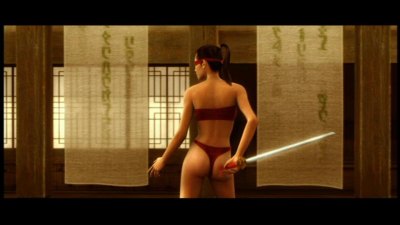
Disc Seven: The Animatrix
This disc is virtually identical to the standalone Animatrix DVD that debuted just prior to the theatrical release of Matrix Reloaded. The menus are the same, except for a unifying element at the very start, involving the Architect's many-monitored perspective.
This anthology of nine anime short films is an excellent expansion of the Matrix universe. The Wachowskis enlisted seven animation artists from Japan, Korea, and the United States to helm the films, and the result is a cornucopia of styles and palettes. Many of the shorts have direct ties into the narrative of the live-action films, and they can illuminate your understanding of the Matrix films' sometimes-labyrinthine plot complexities. The Wachowskis wrote four of the tales and collaborated closely with the animators of the other five.
The nine shorts that make up this DVD are by turns thrilling, disturbingly violent, unrelentingly kick-ass, and—I'm afraid to say—a bit uneven. However, the fool's gold is far outweighed by the real stuff, and in the end, the disc offers an exciting and extremely rewatchable grab-bag of animated gems, comprised of widely varying styles that both enrich your appreciation for the animation medium and provide an eye-popping evening of entertainment.
You can choose to Play All, or you can watch the shorts individually. I wish that the creators of this new set had paid some attention to the menus, because the original menus aren't as user-friendly as I would have liked, but they're not horrible. The disc contains the following nine short films:
- Final Flight of the Osiris—From Andy Jones, one of the creators of Final Fantasy: The Spirits Within, comes the tale of the hovercraft Osiris, whose crew races to deliver a vital message to Zion, as hundreds of evil Sentinels blast toward them. This short premiered in front of the dreadful Dreamcatcher in the spring and is the only one of the nine to have enjoyed a theatrical release. If you've seen Final Fantasy, you'll recognize—and probably be blown away by—the ultra-real computer animation in this piece. B+
- The Second Renaissance Part 1—Mahiro Maeda shows us the genesis of the Matrix, in the form of Zion newsreel archives. You see the meteoric evolution of artificial intelligence and the rise of the machines, and the style of the piece is that of news footage, lending the animation a strange realism, so that you're genuinely appalled by some of the horrific violence that ensues. A
- The Second Renaissance Part 2—This short concludes Mahiro Maeda's contribution to The Animatrix. In the same style as the first part, Part 2 shows us the war with the machines and humanity's downfall, including the inevitable enslavement into pods and the creation of the Matrix. This little film packs a wallop with its stunning battle imagery. A
- Kid's Story—This one, like Final Flight of the Osiris, is directly related to a certain aspect of The Matrix Reloaded. Shinchiro Watanabe (Cowboy Bebop), employing Waking Life-style rotoscoping animation, draws up a tale about a high-school student who is invited by Neo to escape the Matrix. In his frantic search for an exit, he skateboards through his school in a flurry of wild animation. The drawing has a hand-drawn Ralph Steadman hastiness to it that lends an odd depth and energy. B+
- Program—In perhaps the weakest and most derivative of the nine films, Yoshiaki Kawajiri (Ninja Scroll) shows us a Zion soldier taking part in a Samurai cyber-training program. In old-world Japanese anime style, the program involves a duel between Kabuki warriors, but this short doesn't tread any new ground, as it's simply a variation of the training that Neo undergoes in the original live-action film. It also liberally borrows elements of Blade and Crouching Tiger, Hidden Dragon. C
- World Record—Takeshi Koike contributes a super-stylized piece that follows Dan, a world-record-holding sprinter who breaks out of the Matrix in an unusual way. The frequently slow-motion animation has a deformity that, even though it's intended, feels forced and awkward. C+
- Beyond—Koji Morimoto (Robot Carnival) presents an excellent little mind-bender, in which a young woman named Yoko encounters a decidedly strange section of her town, where everything is just a little bit weird. The animation has a gorgeous shifting depth, with its 3D backgrounds and smoothly enmeshed 2D characters. A
- A Detective Story—Shinichiro Watanabe, who also contributed Kid's Story, directed this stylish noir story about Ash, a hard-boiled private investigator who tracks Trinity "through the looking glass." Filled with Alice in Wonderland symbology, A Detective Story tries hard to be great—it has an impressively gritty, black-and-white look—but it just doesn't amount to much. B-
- Matriculated—I had high hopes for this one, and though it's effective in parts, it doesn't quite slam a home run. In this Peter Chung (Aeon Flux) piece, a small group of rebels capture a robot with the intention of programming it to defend the human cause. A long section follows, in which the robot finds himself in the weird world of human dreams, but you'll feel disconnected from the story, too far away from the Wachowski universe and too close to the universe of a wacky Japanese animator. Still, the characters in the real world have a marvelous, gawky look. C+
Image quality of these animated films is exquisite. All the Animatrix shorts appear in absolutely fine anamorphic-widescreen transfers of their 2.35:1 presentation. Across the board, the short films boast a level of fine detail and gorgeous depth that will bring a grin on your lips. In Final Flight of the Osiris, for example, you can study the fine pores of the characters' faces in minute detail. Throughout, colors pop, and black levels are richly deep. All the distinct color palettes are rendered dramatically. I noticed no aliasing along hard lines, and only occasional artifacting. I do have very small complaints, though. First, I noticed the presence of minor edge enhancement in scenes of high contrast. Second, I witnessed a few moments in which mosquito noise reared its head on bright whites. Third, in an isolated case, Final Flight of the Isiris seemed a bit darker than I remember it being in the theater—but still eminently watchable.
Sound quality is also top-notch. The disc includes English, French, and Japanese Dolby Digital 5.1 audio tracks (with appropriate subtitles, including Spanish). Each is full and rich, offering clear and distinct dialog with no brittleness, a punchy and full music presence, and immersive surround effects that are at once entertainingly directional and enveloping.
As for Animatrix-related supplements, you'll find several enticing features under a section labeled Bonus_Data.
- First up is Voices, which you might assume is a flimsy featurette about the various voice actors used in the short films. In actuality, Voices is much more: It comprises four subtitled director commentaries over The Second Renaissance Parts 1 and 2, Program, and World Record. Mahiro Maeda talks at length about the meaning of his two films, but falls into the trap of narrating the action. Still, he has much to say about his inspirations and his interpretation of the Wachowskis' universe. He also points out how events of the film chillingly echo modern-day news items. For Program, director Kawajiri is joined by producer Takeuchi, and two talk about their intention to use two-dimensional "orthodox Japanese animation." Their discussion focuses more on craft and design than on story. Finally, for World Record, Koike and his producer also concentrate on design, for both characters and backgrounds, at one point acknowledging the design influence of Brad Pitt.
- Next is a 22-minute full-frame featurette called Scrolls to Screen: The History and Culture of Anime. In its introduction, much attention is paid to the large debt The Matrix owes to anime, and at the same time, through interviews with the animators involved in The Animatrix, we learn of the great respect that the animators have for the Wachowskis. Then, the featurette gets busy with its history lesson, talking about manga's origins in ancient scrolls and wood block illustrations, then shooting forward to the effect of 20th century American comics pages on today's manga. We then learn of anime's real surge as reflections of historical events such as World War 2 (Grave of the Fireflies is used as an example). The featurette also breaks down and analyzes the style differences between Japanese-style animation (large eyes, static frames, etc.) and American animation.
- Creators is a series of bio sheets on the film's directors and producers.
- Execution is an excellent 55-minute full-frame documentary that's broken into segments focusing on the making of each short film. In fact, you can watch each segment individually from a submenu. The filmmakers talk about their unique approaches to the subject matter, and about their experiences working with the Wachowskis. We also get the reverse perspective, focusing on the backgrounds and personalities of the animators themselves. And we get peeks into the making of the episodes, including tantalizing looks at groundbreaking techniques and processes.
Missing from the original disc is a featurette titled Enter the Matrix: In the Making, a 3-minute preview of the Enter the Matrix video game.
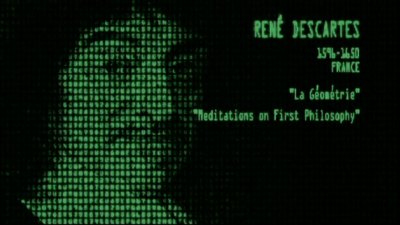
Disc Eight: The Roots of the Matrix
Here's perhaps the most dense and intellectually enjoyable disc of extras that I've come across in my DVD-reviewing years—they're full of foundational information, but the material is presented in an entertaining way, much like the Matrix films themselves. What does it say about me that I was completely and utterly involved with the two deeply exploratory documentaries on this disc, and found them, especially the first one, to be the most enriching of the entire set? Both delve appreciatively into the "jazz mythology" of the Matrix films, exploring the many philosophical and religious and scientific underpinnings of the story. Let me put it this way: You'll gain an extra degree of geek enjoyment from these two documentaries if you can appreciate that they're both 1 hour and 1 minute long (1:01).
I was happy to see that these two pieces, unlike all the material on the Revisited discs, are presented in 1.85:1 anamorphic widescreen.
Return to Source: Philosophy & The Matrix (61 minutes)—This is a fantastic dive into the mind of The Matrix series, taking you through the ideas behind each film, one by one. A gaggle of philosophers (most of them university professors) and science-fiction authors (including Bruce Sterling and John Shirley) revel in their enjoyment of the chaos of influences and ideas that make the films so rich behind the kung-fu and action sequences. Excitedly, they talk about the importance of Gnostic Christianity, Plato's allegory of the cave ("The life you've led isn't the totality of what's possible for you"), Rene Descartes ("What is real?"), George Berkeley ("Reality exists only in your subjective experience"), Immanuel Kant ("The structures of the mind bring forth reality"), Friedrich Nietzsche ("We need to wake up from the herd mentality"), Jean Baudrillard ("The map of the real is more important than the real"), and Robert Nozik ("Would you be willing to plug into a fantasy life and not even realize you're plugged in?"). Then they move on to the second and third film—and as one philosopher says, "The Wachowskis delivered an entertaining action film in the first Matrix, and wanted to bring in more of their riddles, more of their tapestry of ideas, in the second and third films." Essential to The Matrix Reloaded, according to these enlightened commentators, are the Hindu Upanishads ("All things are united as one and come from the same source"), the New Testament ("The Old Testament made new"), Pierre-Simon LaPlace ("What happens at every given moment is determined by the universe's smallest parts"), and David Hume ("How do we know the future will continue to be like the past?"). Even the rave is explained, for you rave-haters: It's a celebration of embodiment and sensuality, which is what differentiates the humans from the machines. You might have also been frustrated by the many times Neo, in Reloaded, faces a choice of two options—binary choices—but the idea of his inability to transcend dichotomies is essential to his character: Neo's a slave to his choices. Philosopher Arthur Schopenhauer is very important to the second film—particularly his ideas about causality and free will. Revolutions is celebrated as a return to enlightenment and at the same time (in the epic battle against the machines) a nod to the Book of Revelations and the Apocalypse. A Taoist sense of balance and harmony is also essential to the final film, and it's interesting to see how the yin-yang notion plays out. It's also no surprise that the humans and machines end up coexisting in peace. Key quote in this documentary: "It's the perfect movie to build a philosophy course around. Modern philosophy begins with Descartes thinking that we're brains in vats." You come away from this documentary admiring the Wachowskis' extraordinary ambition in embarking on a project with such enormous intellectual scope.
The Hard Problem: The Science Behind the Fiction (61 minutes)—This documentary focuses on the saga's notion of humanity's dependence on and eventual slavery to machines. This starts as a rather disturbing look at our increasing interaction with computers and, for example, video games, so that we're more involved with the "reality" of a virtual world than with the real world. Virtual environments have become so real and so artistic and interesting that we prefer those environments and lose sight of our humanity. The mind-body dualism of Descartes is again brought up in this discussion of man as machine, leading into the notion of artificial intelligence, the intricacies of which are talked about in detail. This documentary doesn't offer the kind of specific analysis of the films that the first documentary does, but it's fascinating scientific background material nevertheless. Cool quote: "The first aliens we meet are going to be the ones we invent."
Watch for a series of Easter Eggs that add up to about 20 minutes of additional material. The first is a 4-minute piece that talks about the stages of the Hero's Journey as outlined by Joseph Campbell, and how they manifest themselves specifically in the story of The Matrix. The second is a 4-minute dissection of the very considered names used for the major characters in the films (Trinity and the importance of threes, Morpheus and the God of dreams, Agent Smith and the creation of weapons). The third is a 2-minute piece that discusses the importance of the Merovingian and Persephone in the mythology behind the series. The fourth is a 5-minute piece that talks about the multiple interpretations you can take from the films ("Is Agent Smith the film's Christ figure?"). The fifth is a 1-minute look at intelligent, modular robotics. The sixth is a 2-minute glance at the use of biological molecules in building next-generation computing materials. The seventh is a 1-minute look at people's casual reaction to the notion of an artificially intelligent robot.
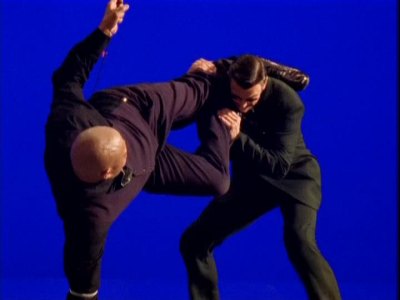
Disc Nine: The Burly Man Chronicles
After wading through the exhaustive material presented on the three individual Revisited discs, you might think there's nothing left to see, but the single documentary contained on this disc will probably change your mind. At this point in my reviewing efforts, I felt a sense of awe as I understood the lengths to which The Ultimate Matrix Collection is going to provide an unprecedented understanding of the making of these films.
The Burly Man Chronicles (95 minutes)—This is a very satisfying, comprehensive, fly-on-the-wall documentary chronicling the making of Matrix Reloaded and Matrix Revolutions, which were shot back to back over a period of about 4 years, beginning in August 2000. Behind-the-scenes footage is presented chronologically, through every aspect of the production, so that you get a real understanding of what exactly was happening when, and what scenes were being shot or prepared for simultaneously with others. Much of the actual information here is redundant from the Revisited discs we've already seen, but for you completists out there (and if you're reading this deeply into this review, you probably are one), there's a ton of new footage, giving you a much firmer idea of the mood of the set, the details of the production, and the day-to-day tasks of the many artisans involved. On the whole, there's a terrific voyeuristic feel to this footage, and it gives you more of a sense of the actual making of the film—within the context of the real world—than anything else in this set.
Follow the White Rabbit—This familiar feature lets you watch the Burly Man Chronicles documentary with a white-rabbit icon enabled. When it appears on your screen (which is quite often), press Enter to access additional information about individual craftspeople involved in the production of the films. (I was surprised to see that these little video segments add up to nearly 90 minutes of additional material!) You can also access these short featurettes in three groupings, as follows:
- Pre-Production—These looks at Steve Skroce, Geof Darrow, George Hull, the Pre-Production process, Kym Barrett, Owen Paterson, and Rock Galotti total 32 minutes.
- Alameda Shoot—These short pieces, titled Rigmaster, Ronumentary, A Day in the Life of Agent Johnson, and Anthony Zerbe, total 16 minutes.
- Australia Shoot—These short pieces, titled Tribute, Roy Jones, Mary Alice, Dessert of the Real, Peter Robb King, Upgrades, Ian Bliss, Publicity Shoot, A Day in the Life of Dr. Cornel West, and The End, total 34 minutes.
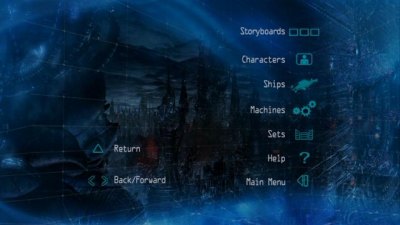
Disc 10: The Zion Archive
Now we come to the more static, non-video-based supplements. Yes, the films' trailers are here, but mostly, this is a collection of slide shows and galleries that show off conceptual art, production design, CG concepts, and storyboards. What I didn't find, however, were marketing materials such as posters and publicity photos, the former of which were quite striking.
The Zion Archive is, hands down, the most exhaustive collection of conceptual and production art that I've ever seen assembled on a DVD. Although its menus are clunky and unintuitive, there's a wealth of information here, if you're into things like storyboards and pre-production art. The archive is divided Storyboards, Characters, Ships, Machines, and Sets, and subtopics beneath those topics take you to quick slideshows of art for just about every aspect of The Matrix that you can think of. I'm amazed by the depth of artwork presented here. The menus are needlessly cryptic, with labels that appear for a couple seconds, then disappear, giving way to mere symbols that you're required to remember. There's even a Help icon that you can click if you forget what the icons stand for. Doing so will bring the labels back, but only temporarily. I found this irritating, particularly because you can navigate only by way of the icons.
The Media of the Matrix is broken down into three subsections for The Matrix, The Matrix Reloaded, and The Matrix Revolutions and gives you a generous array of Trailers and TV Spots, as well as Music Videos by Marilyn Manson ("Rock Is Dead") and P.O.D. ("Sleeping Awake"). I was disappointed to see that both the Teaser Trailer and Theatrical Trailer for the first film are presented in full-frame only, with Dolby Digital 2.0 sound. The sequel trailers fare better, with an upgrade to anamorphic widescreen (but no surround sound).
The 9-minute Rave Reel is a video montage of CG-progression shots, showing glimpses of early versions of finished animation. All three movies are represented, and there's no real rhyme or reason to the imagery that flies at you, but it's a kick to see it all as one cumulative effort. It plays like a hyperkinetic CG music video.
The 10-minute Matrix Online Preview is a sneak peek at a new online-gaming edition of the Matrix video game.
WHAT IS THE MATRIX?
Despite niggling complaints, The Ultimate Matrix Collection is a spectacular achievement in comprehensive DVD film study. It's got some elements you might already be familiar with, and its voluminous supplements aren't quite as perfectly organized as I hoped they might be. However, the presentation of the films is, in many ways, peerless. Image quality, including the new Matrix transfer, is universally fine, and sound quality is above average. The sheer fabulousness of this set—which celebrates the making of, and meaning behind, a uniquely innovative sci-fi techno wire-fu cerebro-noir saga—easily deserves DVD Talk's very highest recommendation. Free your mind with this year's finest DVD set.
|
| Popular Reviews |
| Sponsored Links |
|
|
| Sponsored Links |
|
|
| Release List | Reviews | Shop | Newsletter | Forum | DVD Giveaways | Blu-Ray | Advertise |
|
Copyright 2024 DVDTalk.com All Rights Reserved. Legal Info, Privacy Policy, Terms of Use,
Manage Preferences,
Your Privacy Choices | |||||||












